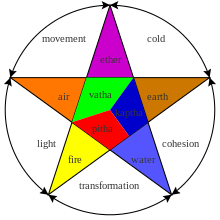 This week, I’m doing a live Shift chat with Aparna Khanolkar, who I had that wonderful video conversation with a few weeks back. Since Aparna’s approach to health and life has deep foundations in the ancient traditions of Ayurveda, I thought I’d do a bit of an introduction to Ayurveda here. It’s something that I’m very drawn to, not only because of its incredibly rich heritage, but because its health principles (so far as I understand them) resonate very deeply with me. It’s the original philosophy of whole wellness.
This week, I’m doing a live Shift chat with Aparna Khanolkar, who I had that wonderful video conversation with a few weeks back. Since Aparna’s approach to health and life has deep foundations in the ancient traditions of Ayurveda, I thought I’d do a bit of an introduction to Ayurveda here. It’s something that I’m very drawn to, not only because of its incredibly rich heritage, but because its health principles (so far as I understand them) resonate very deeply with me. It’s the original philosophy of whole wellness.
Ayurveda is a 5,000-year-old system of natural healing that has its origins in the Vedic culture of India. In recent years, Ayurveda has been enjoying a major resurgence in both its native land and throughout the world. Tibetan medicine and Traditional Chinese Medicine both have their roots in Ayurveda. Early Greek medicine also embraced many concepts originally described in the classical ayurvedic medical texts dating back thousands of years.
More than a mere system of treating illness, Ayurveda is a science of life (Ayur = life,Veda = science or knowledge). It offers a body of wisdom designed to help people stay vital while realizing their full human potential. Providing guidelines on ideal daily and seasonal routines, diet, behavior and the proper use of our senses, Ayurveda posits that health is the balanced and dynamic integration between our environment, body, mind, and spirit.
 Ayurveda describes three fundamental energies that govern our inner and outer environments: movement, transformation, and structure. Known in Sanskrit as Vata (Wind), Pitta (Fire), and Kapha (Earth), these primary forces, or Doshas, are responsible for the characteristics of our mind and body. One Ayurvedic theory states that each human possesses a unique combination of these doshas which define this person’s temperament and characteristics, a balance of the three Doshas, equals health, while imbalance equals disease.
Ayurveda describes three fundamental energies that govern our inner and outer environments: movement, transformation, and structure. Known in Sanskrit as Vata (Wind), Pitta (Fire), and Kapha (Earth), these primary forces, or Doshas, are responsible for the characteristics of our mind and body. One Ayurvedic theory states that each human possesses a unique combination of these doshas which define this person’s temperament and characteristics, a balance of the three Doshas, equals health, while imbalance equals disease.
Each person has a natural state, or natural combination of these three elements, and should seek balance by modulating their behavior or environment. In this way they can increase or decrease the doshas they lack or have an abundance of respectively.
- If Vata is dominant in our system, we tend to be thin, light, enthusiastic, energetic, and changeable. When Vata is balanced, a person is lively and creative, but when there is too much movement in the system, a person tends to experience anxiety, insomnia, dry skin, constipation, and difficulty focusing.
- If Pitta predominates in our nature, we tend to be intense, intelligent, and goal-oriented and we have a strong appetite for life. When Pitta is balanced, a person is warm, friendly, disciplined, a good leader, and a good speaker. When Pitta is out of balance, a person tends to be compulsive and irritable and may suffer from indigestion or an inflammatory condition.
- When Kapha is dominant, we tend to be easy-going, methodical, and nurturing. When Kapha is balanced, a person is sweet, supportive, and stable. But when Kapha is out of balance, a person may experience sluggishness, weight gain, and sinus congestion.
Although each of us has all three forces, most people have one or two elements that predominate.
An important goal of Ayurveda is to identify a person’s ideal state of balance, determine where they are out of balance, and offer a broad range of interventions using diet, herbs, aromatherapy, yoga, massage treatments, music, exercise and meditation to building a healthy metabolic system, attaining good digestion and proper excretion to reestablish balance and build vitality.
If you’re interested in identfying your dosha, I found a fun and simple questionnaire on the Chopra Center’s site that can help you determine which ayurvedic element is most lively in your nature. Take the dosha quiz here.


